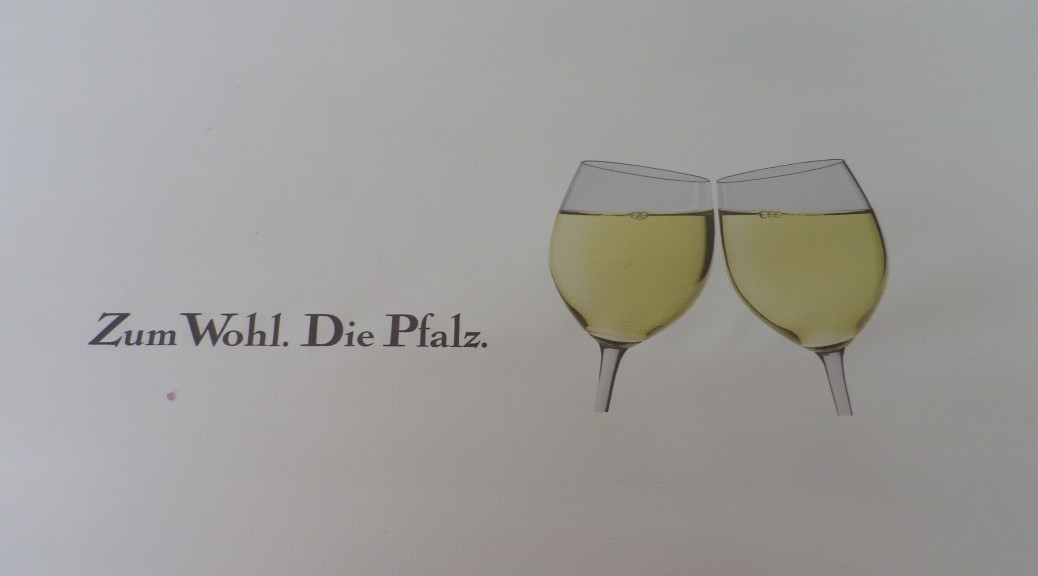What I Learned:
The Pfalz has a long history of wine making. Grapes were cultivated and processed into wine even in the early days of Roman settlement along the Rhine. The implements found throughout various sites in this part of the Pfalz, some of which are in the museum in Edenkoben, bear witness to this long history. The tradition continued with the establishment of regional monasteries, such as the one in Wissembourg, France, just south of today’s Weintor in neighboring Germany, dating to the 600s; and important dioceses’ centers in old Roman districts, such as Worms and Speyer. (Church services required wine, hence vineyards for the raw material.)
The terrain here is ideal for growing grapes. From the east, the floor of the valley of the Rhine gently rises, becoming foothills backed up to the mountain range of the Haardt, a range beginning west of Schweigen, and continuing north to roughly southwest of Worms. (The Vosges mountain range in Alsace, France, is the southern extension of this range.) This area is characterized primarily by red sandstone. The mountains shelter the grape-producing, eastward-facing foothills, creating good climatic conditions for the grapes.
The VDP authorizes the cultivation of over 60 varietals in the Pfalz wine region. Of the varietals locally, Riesling has always played an important role, especially in the northern part of this region. Mueller Thurgau is also an important white varietal, especially in the south. Weissburgunder, known as Pinot Blanc elsewhere, is another white wine grape that is planted here, although in far smaller quantities. As for the red varietals, there is Dornfelder, the most widely cultivated red wine grape locally. As a percentage of red wine grapes grown, it has overtaken the traditional favorite: Portugieser. Spaetburgunder, aka Pinot Noir, represents a full 7% of the grapes planted, and is gaining in popularity.
What I Tasted:
2013 Riesling, Trocken, Doerrenbacher Guttenberg, Qualitaetswein, Knoell und Vogel, Bad Bergzabern: a prize winning dry, white wine with pale gold color: fruity, with trace of minerality, and mild acidity; very balanced.
2013 Riesling, Trocken, St Martiner Schloss Ludwigshoehe, QbA, Weingut Holger Schneider, Sankt Martin/Maikammer; a dry white with a medium gold color, slightly tart and minerally, with herbal notes. The taste of the grape come through nicely.
2013 Chardonnay Pur Mineral, Qualitaetswein, Weingut Lergenmueller, Hainfeld: a dry, white wine with dark gold color, has a wonderful, clean grapefruit smell, minerally, with a slightly sweet fruits taste.
2012 Auxerrois Kabinett, feinherb, Weingut Nicole Graeber, Edenkoben: smooth, fuller bodied than many Pfalz white wines, nice bouquet, some tasting depth and interest.
2011 Cuvee Abendrot, Kloster Heilbruch, Edenkoben: a very nice blend of local reds, drier and fuller bodied than most German red wines. As the name suggests, for evenings this red is a pleasant sipping wine.
2011 Weissburgunder Auslese, Weingut Kaufmann Ziegler, Weyher: very sweet, intense nose, full-bodied mouthfeel, almost syrupy.
2012 Riesling Weyher Michelsberg, Kalkmergel, Weingut Graf, Weyher: dry, sweet, really taste the Riesling grape
2012 Alte Reben Altenforst, Schieffer Steillage, Weingut Rudi Moewes, Burrweiler: prickles on the tongue, dry, minerally, solid mouthfeel.
2012 Weissburgunder Sekt: Weingut Wilhelmshof, Siebeldingen: good body, pleasantly effervescent, but the flavor from the grape itself was almost too powerful. (I like my bubbly more nuanced, and drier than this one.)
Weingut Teutsch: About a kilometer and a half from the DWS WW on the west side of Edenkoben, next to the historic Cistercian Cloister Heilsbruck. It’s a great spot to relax and taste in a relaxed atmosphere. Family run, (and the vinter from a family who has been making wine for over 400 years), they have a nice variety of wines to taste and choose from.
2012 Riesling Edenkobener Schloss Ludwigshoehe: dry, rather tart, more thin-bodied than full-bodied, great well chilled on a hot day.
2011 Kerner, Edenkobener Schloss Ludwigshoehe: full-bodied mouthfeel (almost syrupy) and flavor, intense floral aroma, smooth and memorable.
2011 Grauer Burgunder, Edenkobener Schloss Ludwigshoehe: a spaetlese, sweet-tasting, full, almost thick-bodied, fruity-flavored wine.
2011 Dornfelder, Edenkobener Schloss Ludwigshoehe: this red wine was dry, and medium bodied, with a smooth finish. Cherry flavors predominate.
